From childhood I was drawn to the natural world. My first two books, read at the age of 7 or 8 were The Oregon Trail by Frances Parkman, then A Zoo in my Luggage by Gerald Durrell. My impoverished childhood found riches beyond money and, ever since, adventure and natural history drives my world – without cash it’s still there, with cash I can go further. My local Sussex walk takes me through two miles of orchard, arable fields, coast and marsh, so always gives a surprise.
Stag Beetle
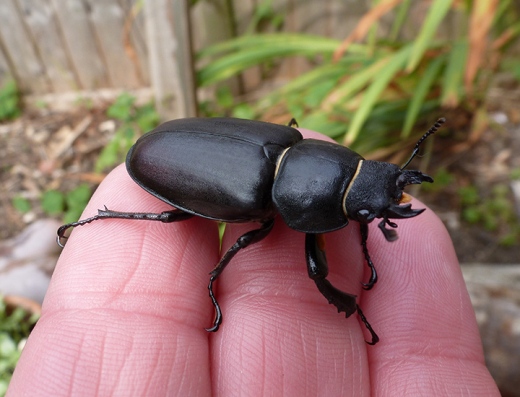
Last year I found four stag beetles. One male was dead and a second pretty knackered, wandering in the orchard like a vanquished knight. The third, a female, put in an appearance in my friend Harv’s house. It was the fourth, a feisty girl on a path in the local Big Field that stole my heart. She looked very healthy, but was in danger of accidental or purposeful squashing, so I popped her in a bag and took her home. In my garden I held her for a while and admired her great strength pushing my fingers, yet she sat happily on my open hand. I thought she may fly, but she stayed. I offered her my log pile. She hesitated, adjusted to fly, then, with great purpose, strode from my fingers into the wood. Now I hope she was a mated lady and at some point in six years or so, her children will emerge.
Hornet Mimic Hoverfly
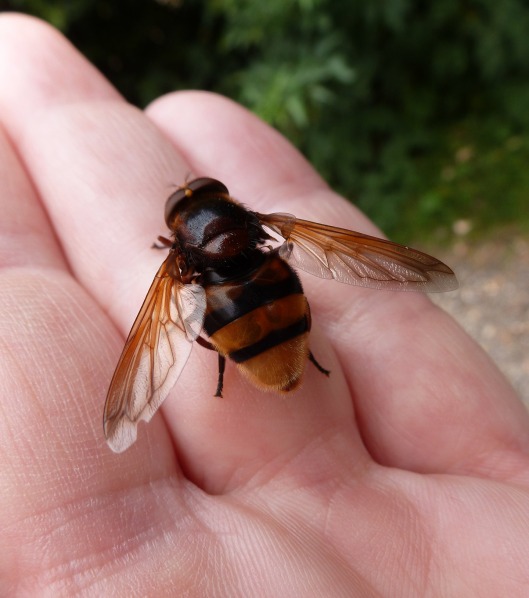
On a hot summer’s day I was walking in the local orchard when, there before my eyes, a hoverfly hovered, giving action to its name. There were several of these large beasts, each returning to a nearby privet hedge after its burst of high energy, but static flight. I offered my hand to one insect and it decided to use it. For five glorious minutes this Volucella zonaria, a hornet mimic hoverfly, flew from and back to my fingers and shuffled around occasionally as if to look at me in mild, but grateful surprise. Try this yourself with hoverflies – it does work if you are patient.
The Purposeful Wasp
As the summer fades and the world’s tilt encourages autumn to jog towards winter, wasps become listless and unpredictable. The German wasp Vespula germanica and common wasp V. vulgaris are two species found in Britain and both tend to be loathed and feared by most. Each, however, is its own wasp and regards us with little interest because they do waspy things to survive regardless of the view of creatures in general, and humans not in particular. I took the pictures of this queen V. germanica at the Arundel WWT last May. She was collecting wood shavings to make a nest and was oblivious to me watching closely. You see, she was a Purposeful Wasp.

Although my main interest drifts towards birds, I have become very fond of insects over the years. As with most youngsters I was taught that anything with more than four legs, especially something that buzzes, and absolutely a creature bedecked in a yellow and black livery, must be avoided or obliterated. Avoiding took the general form of running around yelling “Jasper!” and waving ones arms; whereas obliteration was achieved by a rolled up newspaper. Such was the fear inherent in my West Country village that ‘wasp traps’ were put out in the form of unwashed jam jars full of water. These quickly became a struggling mass of drowning creatures. These too were Purposeful Wasps.
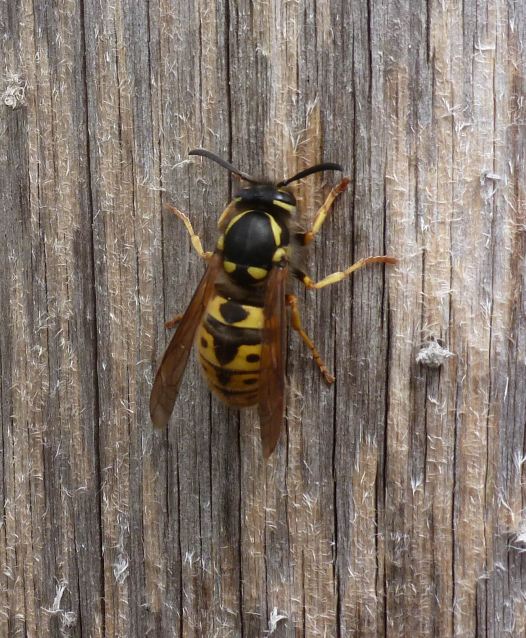
I like wasps. I even paused on a long run in the summer to watch a fine hornet hunting near West Ashling. So, what is a Purposeful Wasp? In spring the queens crawl out from hibernation and find a nice place to start a family. She chews off strips of dead wood (untreated fences are favourites) and builds a small nest in which her first eggs are laid. These become her workers and she retires to lay more eggs. The year rolls on. Each wasp has a duty – gathering wood or food or defending the nest. In late summer males and virgin queens are produced, the old queen dies and the colony dies over the autumn months. All through this time wasps are Purposeful. They fly direct to a source of food or wood and directly back to the nest. The map in their little brains sticks and they return time and again until the resource is exhausted. Then they quickly learn and stop their pattern, searching out other resources.
Through the first phases I have found that wasps have no innate need to attack the peaceful observer. I’ve even had them fly through circled fingers and thumbs without deviation. I don’t advocate messing around near nests, but at food and wood sources I have never been stung. A wasp with a purpose can be read quite easily, and observed quite safely. By autumn, though, the wasps are effectively marooned automatons with no leader. Then they are the Jaspers of my childhood and will sting.
Imbolc to Spring
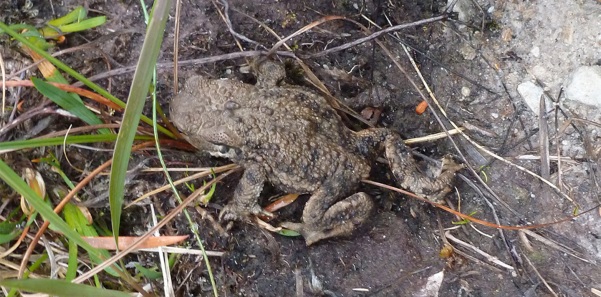
Now introductions are done I can start the blog proper. Over the months I shall describe my training and mention anything of note that drifts my way. I shall also explain my beginnings, my fall into being a blimp, and my simple system of regaining health and fitness. For this you only need three things: honesty; hard work; and a desire to live.
2016 has meant an adjustment in jobs and a lot of travel. Most weeks I am in a different city, or town and the impact on my training seemed fatal. Last year I ran 1300 miles. This year I aim to run further – I have to condition my body to endurance running. The trouble was I tend to be programmed to run my familiar routes, so lacked discipline to run away from my base. Honesty – I was self conscious of running from large hotels. Desire to live – feck it, let them laugh (no one does). Hard work – I now run whilst away. The best trick is to do a little research and take in the sights. I carry a map and forget the watch. In Plymouth I ran around Mount Wise and looked across Drake Island, then along the Tamar to the Torpoint Ferry. In Cardiff a long run around Cardiff Bay. Swansea 6 miles in the drizzle to Mumbles and back. Eccles – 7 miles through the new Media City, around Old Trafford and back. The next week a 5 taking in Bangor Pier – wonderful standing in the centre of the Menai Straights! Last week, on an extended stay in Liverpool, I did two runs. The first a loop along Penny Lane to Strawberry Field which gave me acute nostalgia, so I ordered The Magical Mystery Tour album and dreamed of T-bar sandals and hot summers. The next day a run along the waterfront – 8 miles dodging turnstones and dirty fidos. Thus my midweek mileage is up and my geographic knowledge growing.
Imbolc is an old festival between the winter solstice and Spring Equinox. The evenings draw out and running in the dark can be rewarding. Running through the quiet village of Chidham a few evenings ago, my headlamp beam picked up the marching form of a determined male toad. I stopped and picked him up. Roads and toads do not mix well. He struggled, the strength of him a surprise, but such is the desire to find a large female somewhere close. Into the grass he went. He briefly gazed at me, shuffled round and set off due north through the grass. A dozen paces later, another, and the same ritual. Next day, in the light, there were no signs of flat toads, so I felt good. Spring moves quicker than the Reaper Man, so my pace will increase and he’ll slip further behind once more.
Beasts on the Bourtzi
I have made several trips to the Greek Northern Sporades, each of which have given me plenty to write about. As time goes on I will add some of these to this blog, but the most recent journey saved a treasure for the last day.My Passepartout and I had just completed a birthday holiday to Alonnisos and after a fast and furious transfer by water taxi were waiting in Skiathos Town for our flight. As is our habit we ate a light breakfast at the El Greco Taverna. After this we had a few hours to kill and I led us to the Alexandros Papadiamantis monument on a little promontory called Bourtzi.
Bourtzi is a tiny peninsula that divides the Skiathos port into two distinct parts. It used to be a fort, which was built by the Gizi brothers who ruled over Skiathos back in 1207. Bourtzi was bordered by impregnable walls and there were two towers located to the left and right of the main gate. It still divides the old and new ports, but the only signs of a fort are some hefty ramparts and some corroded canons. The centre is dominated by an open-air theatre and arts centre. We walked under the trees in a clockwise direction, eventually scrambling down onto a rough path over the rocks along the water’s edge, circumnavigated the end of the peninsula, then turned back towards the old port.
On a rock shelf at the base of some steps leading us up to our path, we tarried, watched the sea and took some final pictures. It was here I noticed some German wasps Vespula germanica flying around a dead fish in their purposeful way. At first I thought the poor creature was a garfish with its long mouth snapped off, but now I’ve looked at the photographs it turns out to be a silver eel. The wasps were their purposeful selves and ignored us completely, posing without ire for the attached photograph. They were settling on the eel and delicately carving small slices, before flying away to their nests, to be replaced by a compatriot. Rather than ghoulish, it was a gentle and choreographed dismemberment, set off by the colours of the cast. The wasps were at their best in yellow and black, looking bright as wax in the Greek sunshine. The eel was quite fresh, so its skin still radiated colour, but its still bright eye, blue and clear, gave vibrancy to the scene, notwithstanding the fact it was dead.
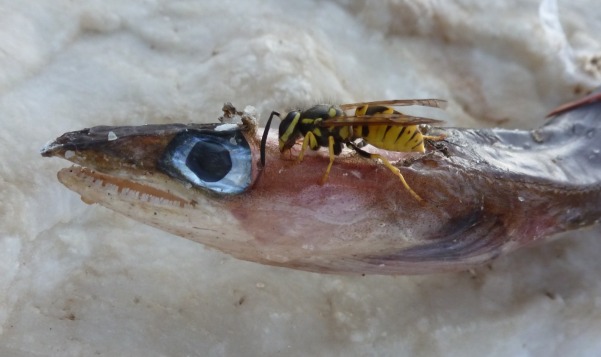
We left the wasps to their clearing up and walked up the steps under the trees to sit and watch Skiathos Town. Across the water people were clearing up the remains of their early selling spree in the fish market watched by the local cats, and customers gently sliced their fish lunches in the tavernas. Fishing boats were setting out again past the wasps below. Isn’t life lovely?
Pine Martens and Digestives
I have not missed a visit to the Scottish mountains in the last ten years. Choosing where to go each time could have been fraught with difficulty, but becoming an accidental Munro Bagger gives a gentle discipline to such dilemmas. I stay close to the Munros I have yet to ‘bag’ and there are lots still waiting close to one of my bases near the Kyle of Lochalsh – Craig Highland Farm. This steading clings to wooded slopes overlooking Loch Carron and is sheltered by prevailing westerlies by the Plockton headland. I discovered Craig many years back and it has now become my favourite base in the Western Highlands. Surrounding the owners’ cottage is a working farm, interspersed with a scattering of wooden lodges and stone cottages. The property is tight to the shore of the tidal loch, reached by crossing the Kyle of Lochalsh to Inversess railway line, and takes in the little wooded Eilean na Creige Duibhe. From the vantage point of the lodges one has tremendous views across to the far side of Loch Carron and even sight of the road winding up Bealach na Bà towards Applecross.
Suffice to say, there are many birds and beasts to see around the farm and across the loch, so the lack of WiFi or television becomes an irrelevance. Outside the windows, locally purchased bird food entices all the common species including siskins and great spotted woodpeckers. At dusk the bats come out whilst the birds still feed, but it is as darkness falls that the farm comes into its own. These woods are home to pine martens.
The pine marten is that large and mysterious member of the Mustelid (weasel) family one sees on Springwatch and in nature books, decked out in thick red-brown fur with a creamy shirt front. Its preferred habitat is thick woodland or rocky hillsides, with dens frequently made in hollow logs or rock crevices, but also in rabbit burrows or the roofs of old buildings. They are nocturnal omnivores, eating anything from squirrels and beetles, to fruit and digestive biscuits. Anyone who loves natural history would have the pine marten as a ‘must see’ species, but they are so elusive they have to be sought out. Craig is right in the middle of their expanding Scottish stronghold, so sightings are frequent to the point of being guaranteed, if one is patient.
With my Passepartout I have seen them trot across the road as I’ve driven slowly to and from the farm, but to entice them the ideal bait is peanut butter or jam spread liberally on digestive biscuits. With such strategically placed comestibles outside your window at dusk, it is time to sit back and wait. Typically little voles and woodmice may come out for a nibble, whiskers trembling, eyes bright, their bodies tensed to dash for cover. Bats dip into view and the sinister, dark upon dark silhouette of a tawny owl may drift over. Pine martens never hint at appearing, they just arrive in a hefty, brazened, spectacular materialisation.
It is not until one gets a windowpane’s thickness from a pine marten that you realise how heart-stoppingly powerful and beautiful they are. Dense, rich fur in ranging from deep chocolate to foxy red, the creamy bib with little spots unique in each individual. A teddy-bear head, but more Steiff and feline, than round and cuddly. The legs are thick and muscular with large, strong, clawed paws, ideal for climbing. Indeed they are reminiscent of an oriental short-hair cat, not unlike my Passepartout’s house cat at home. Such is the likeness that I once, with a spoonerismic slip, called this black, needy creature ‘Cyril’ instead of her correct apellation, Cilla, and now pine martens have become Pine Cyrils as an accidental but accurate application of that simile.
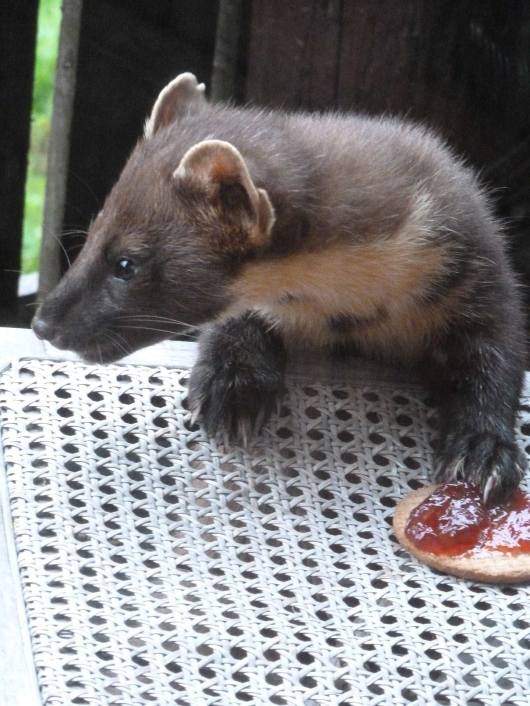
Once discovered the pine marten will grab a fully loaded digestive and run off to consume out of sight, or, if the watcher is very lucky, eat it there and then in the torchlight. We’ve been lucky enough to see single adults and, occasionally a female with a couple of half-grown kits. They live around Craig and are part of the farm’s ecosystem. Even though they will kill and devour any chicken, duck or guineafowl left out after curfew, they are welcomed, sometimes with a curse, but never with cruelty.
Thus we will return armed with digestives and peanut butter knowing the pine martens will show up. You may note that I’ve stopped using jam – it may be bad for their ferocious, shiny teeth…
Spiny Creatures
As a child my only encounters with hedgehogs was as dinner-plate sized roundels on the road. In those distant days of two TV channels and no internet, one had to learn about nature through diligent research via libraries, observation and anecdotes, the latter seldom consistent to reality. I was also not allowed to go out after dark by a stern mother, the logic of which was lost on an ever active child. Subsequently, I have seen many living hedgehogs, more-so in Sussex than my home county of Somerset, but such encounters have never lost their excitement for me. They can still be elusive, and in 29 years of shift work at the Royal Ordnance Factory at Puriton, I saw hedgehogs on but three occasions. I recently found an old photograph of me holding a hedgehog which I rescued from in front of my car somewhere near Brean Down on the Somerset coast.
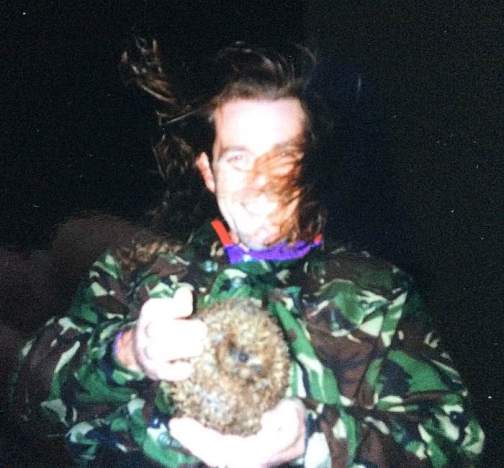
The common hedgehog, Erinaceus europaeus, is found all over Northern and Western Europe and is one of the most recognisable mammals out there. My fondness for them is deep, even though they are not the brightest of creatures and seem not to have evolved a reverse gear. I’m guessing that any need to reverse hits the ‘danger’ circuit in their little brains so they have developed a far less strenuous strategy – they curl up. Anyone who had picked up a hedgehog in its defensive pose will attest to the fact that they are very spiky. A good defence against predatory paws and noses, but pretty useless against pneumatic tyres. I think it is their single minded forward motion, clockwork-toy gait and half-hidden trundling legs that get me. And they have adorable faces etched with innocence and resignation when examined close to – if they choose to uncurl. I am now fortunate enough to have them as regular visitors to my garden, all dubbed Hubert by my granddaughter.
As natural selection is influenced by ecological niches and limited to what various gene sets will produce, the successful model of the hedgehog has appeared in other species. My own encounter with such parallel evolution was in the 90s on the island of Réunion. I had been climbing over volcanic peaks with the beautifully oddly named Dutch Alpine Association, finally scaling the live volcano of Piton de la Fournaise (‘peak of the furnace’) before descending to the coast at Saint Joseph. To reach that town we had to make our way down into the deep gorge of La Roche Plate through thick forest and alongside a roaring stream. I swam under a waterfall here, in the buff, so achieved another of life’s dreams. The lower trail was rocky and long, but we reached our final camp just before darkness fell. The trek had been wonderful, full of supreme views and exhausting, but rewarding scrambling over dusty trails and igneous ridges. It was in this dark, bosky grove I was rewarded with two lifetime firsts. Above, a coven of witches chattered and scolded, eerie enough to raise the hairs on ones neck. These were Barau’s petrels flying into their nests under the cover of darkness high on the cliffs some 300m above. (I later saw them in daylight beyond the reef at St Pierre waiting for evening to come.) Next came a beast that I can only describe as mildly mentally ill. The common or short-tailed tenrec, Tenrec ecaudatus, is a spiny creature that had been introduced from Madagascar. It looks superficially like a hedgehog, but is sharper faced, paler and a completely different family and genus, though it eats pretty much the same mixed diet. I found several wandering near the camp, but they had the tendency to stop, curl up and nod off with the least provocation. They had no fear of me at all, or anything else as far as I could see, and are the most laid back creature I’ve ever met to date.
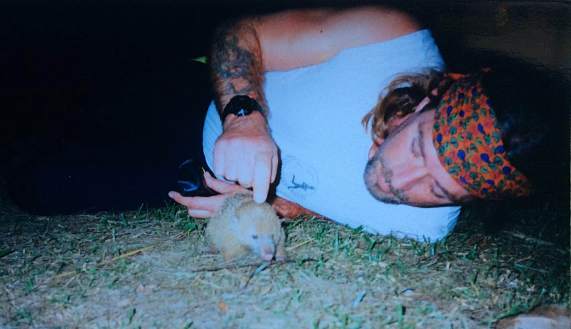
For the second time this year we were on Alónnisos, this time for our birthdays, and on the way back from Patitiri to our hotel on the night of my 61st, just by the Paradise Hotel, we came across a very healthy hedgehog wandering around at the top of some steps. This is the southern white-bellied hedgehog – a different species to ours, though very similar. They are lighter, less prone to being startled and equally lovely. I reassured my Passepartout that the little fellow would be fine and we left him amongst some pots.
The next morning we left the hotel for town and as we reached the steps my companion asked, “I wonder if the hedgehog is alright, he may have been stuck on the steps.”
I scoffed and said, “Of course he is, he’ll know the place like the back of his paw…”
Just then I saw the hedgehog wandering around a small hotel foyer halfway down the steps.
“Er, there he is,” I said. “I think he’s stuck…”
The little creature was whiffling his nose at the door as if he were a resident trying to get in having lost his keys. It wandered along the step by us and it gave me the impression of not being able to climb up. It would have to work its way down in daylight, before trying to find somewhere to sleep. After a debate I picked the little fellow up in my hat. He never curled up, but watched the world go by over the brim, looking for all the world like a sultan with a spiky headdress on. We put him down in some rough grass, whereupon it made a beeline for a digger bucket, shuffled into the leaf and grass litter beneath and fell asleep… we read that southern white-bellied hedgehogs tend to make surface shelters of grass, so his actions were pretty normal. Later in the evening we rechecked, but he had gone hunting leaving behind a round hedgehog-shaped depression.
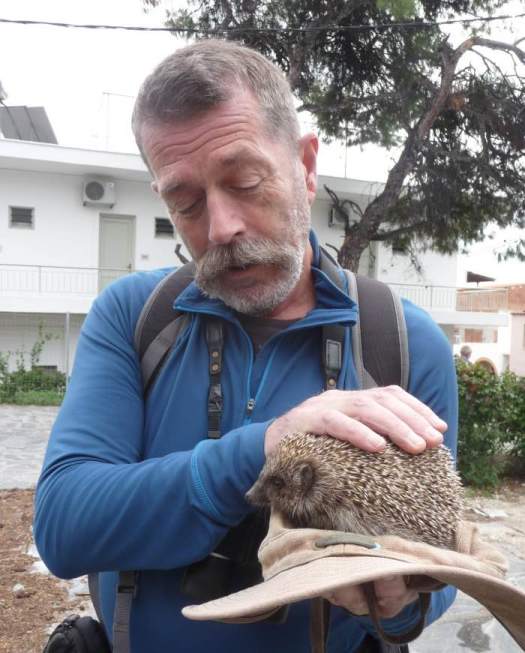
That is the thing with life, only humanity makes me frown. I can never remember a sad moment linked to little creatures, especially spiny ones…
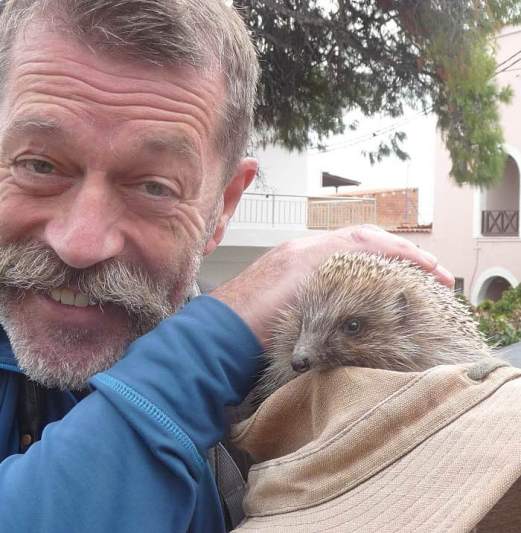
Of Hermes and a Golden King
As I dally with the thoughts of Alónnisos and Greece, I often skim over information on the old gods. Whilst pensively considering the stage of my training this week, I came across Hermes and he immediately became one of my favourites. He was the messenger of the gods (renamed Mercury by the Romans), a divine trickster who rather liked protecting people for the meddling proclivities of his realm and was also viewed as the protector and patron of roads and travellers.
In my own metaphor, the Reaper Man pursues me. To quote Chris Lashelle, “The Devil keeps chasing me, And I keep pushing through this pain, He tempts me to lie down and die, Putting an end to my struggling mind…” How apt that has seemed to me through these dark winter days. I need a guardian of my road to Alónnisos. Yet, as with most Greek mythology, Hermes could also be the conductor of souls to the afterlife! So, perhaps I will forego his assistance for the now.
Yet myth is most often begotten in wondrous reality, and such was my uplifting by of the King of Birds some eight miles into a 12 mile run last weekend. I had trotted happily along undulating roads over the South Downs on a cold, clear afternoon, but as a skimming of cloud turned the world a winter monochrome my spirit dropped. I plodded along the flatland lane, hemmed in by deep drainage ditches, looking across stripped, wet arable fields. Then, to my left, down in charcoal sketched blackthorn branches and dead reeds a tiny supernova of colour flashed. Golden – so yellow in the gloom, that my heart missed a beat. A goldcrest was seeking out enough mites and midges to keep its tiny life afire through the night. It looked well, even if need had pushed it to hunt in a stunted thorn over chilly water. The final miles were easy – if this green and gold kinglet could survive out here, I could run home.
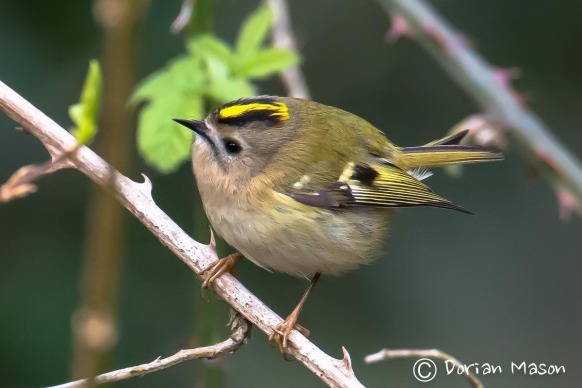
This kinglet, the name of a small group of Old World Warblers, Regulidae in Latin, is our joint smallest bird along with the firecrest. There are several stories in folklore about the wren becoming King of the Birds as it hitched a ride on the eagle’s back, and once the eagle tired, flew a little higher to claim its crown by flying highest of all. However, back in the day, many of these little leaf warblers were known as ‘willow wrens’, so I have always thought the goldcrest to be the king, after all it has the golden crown. To support my case, its Latin name Regulus regulus is a diminutive of rex, a king.
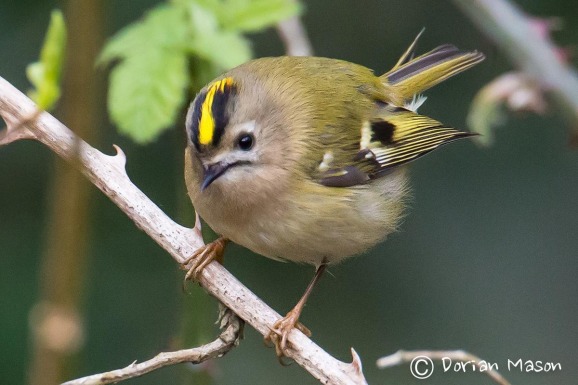
The lesson for me is that metaphors, myths and metaphysics look fine in print – abstract, with little substance in the real world. Reality is my constant companion as I run towards my 34,000th mile. Every now and then, my train of thought gives way to a flash of gold in the undergrowth as the little kinglet shows his crown and my life is fuller for it.
With that in my minds eye, Sol sank in the west as I completed my run, painting the clouds golden. Two sleeping kings were out there as I got into my warm home. Both will warm my days as long as I keep on running. What more could a chap ask for?
Thanks to photographer Dorian Mason for the use of his work, more of which may be found here
2019 Bothday
Bothday? The first thing I must explain is that noun. My Passepartout and I have autumn birthdays but 4 days apart. Three years ago we eschewed separate birthday presents and made a convergence of both events to make a single, week-long celebration, our Bothday,…and went on holiday to Alónnisos. It worked so well it has become an annual event. It takes us away from unnecessary, formal attention, and gives us a chance to let the next digit be added to our totals, without too much fanfare. In 2018 we toured the West Country and our 2019 Bothday, the subject of this blog post, was a happy return to the far north of Scotland.
Having deposited Passepartout’s ageing feline in her luxury hotel and driven to the Midlands to spend a little time with parents, we dropped Passepartout Junior at University and continued up the M1 to begin our journey proper. Rather than write anew, I’ll use selected highlights from my diaries…
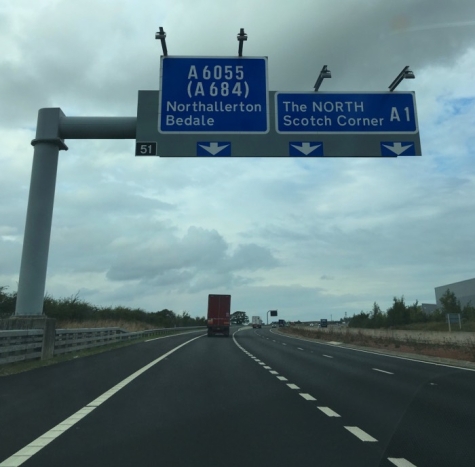
Day 1: Bedale
We reached Bedale at 15:45. The Manor House Hotel where we have the Chinese Room – super. A welcome in the form of a pot of tea and some cake was appreciated.
Down to the Main Street (Market Parade). Had a wander then 2 pints of beer for £4.80! So cheap. Ate a lovely meal at Panetti’s Café Bistro, shared a bottle of red, then toddled back to our room… we ordered breakfast for 08:45…
Day 2: Bedale to Dunphail
Awake by 06:30, made room-tea at 07:00. Showered and packed, then down to join the other residents for breakfast: tea, toast and scrambled egg with smoked salmon. Everyone was nice and we nattered a bit too long. Set off at 09:45…
Up the A1M – the roads were relatively quiet so we made good time. Very exciting to see Anthony Gormley’s Angel of the North, and then a slower drive in the heavier traffic as we passed Newcastle. By the time we went by Morpeth the road was clear again. A brief stop at a services, then on: saw the Farne Islands; skirted Berwick-upon-Tweed; then saw Bass Rock on the run in to Edinburgh. Skirting that fine city, we crossed the Firth of Forth on the beautiful new Queensferry Bridge. We saw the older road bridge, and the Victorian Forth Bridge too.
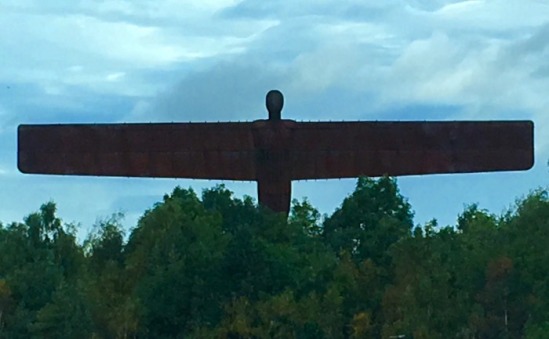
Made good time, passed Scone, then had a diversion before reaching the Cairnwell Pass. Here we stopped at the Glenshee Ski Centre for a coffee and cake in the drizzle. Onwards towards Tomintoul, a red squirrel ran across the road, then on to Grantown-on-Spey. From here it was a quiet final push to Dunphail where we were greeted by my brother and his delightful wife. 334 miles trouble free.
A quiet, funny night – veggie soup, the apple cake and ice cream… slept…
Day 3: Dunphail to Tongue
A light breakfast. A lot of laughter and we were sent on our way with some apple cake and a hug. Fuelled up in Forres, then on to Inverness, over the Kessock Bridge and into the Far North, through the Cromarty Firth, Dornoch Firth, Brora and Helmsdale, on through Wick and up the East Coast. Lots of swallows still migrating south.
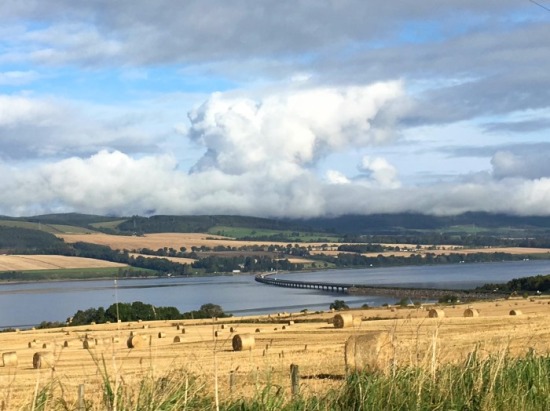
We eventually stopped at a John O’Groats for a stretch, some pictures and a fruit scone and coffee. Lots of gannets flying offshore and many swallows feeding over the little harbour. Several red admirals were flying south.
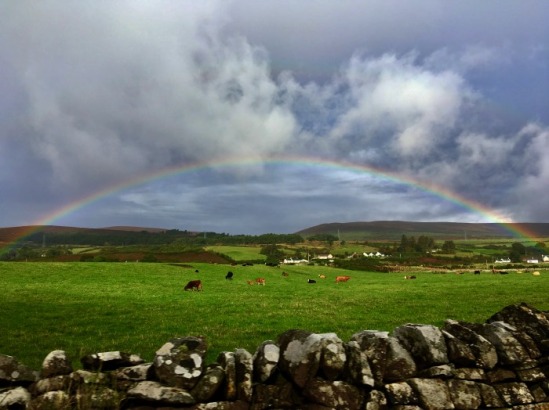
On to Dunnet Head where we sat watching a heavy shower. Despite my insisting that to see a cetacean of any kind was unlikely, Passepartout confounded me by spotting a pod of 5-10 dolphins feeding some 800m away. Shows what I know! The rain stopped, so I whipped on some running gear and trotted half-a-mile down the road and back to record my northernmost possible run on the British mainland.
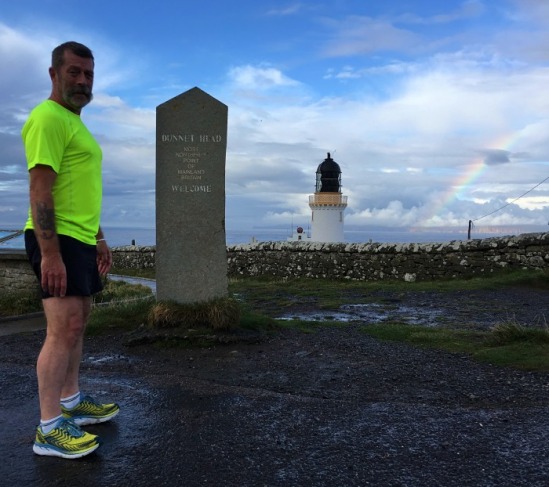
The final 64 miles to the Tongue Hotel took us along the North Coast, seeing the large site of Doonreay, and wilder, shower-soaked peat bogs, lochs and cnocks. The Tongue Hotel…Olde Worlde luxury. Through the window we can see Ben Loyal… lovely. Great shower and down for fantastic haddock and chips – light, crisp and perfect with a glass of Merlot. We are both tired, so an early night beckoned.
Day 4: Tongue – Penny Farthing – Pies – Culkein
Being the far north, the night was silent and it was peacefully dark, so, our sleep was wonderfully refreshing. Last night we had made a dent in the small decanter of sherry (complimentary) so it aided our drift into the arms of Morpheus.
I made tea at 07:00 and we ate our equally complimentary Tunnock’s choccie marshmallows. I showered – hot and of sandblasting ferocity – and then we toddled down the galleon-creaking stairway to the Dining Room. Veggie breakfasts, toast, tea and a coffee. Booting out time was 11:00, so we decided to make the most of the luxury. Passepartout had a bath and I caught up with emails and the news…the TV remained off.
The Tongue Hotel is worth every penny and we will use it in the future. We set off at 10:30 in fine rain and pressed on towards Durness. The rain stopped as we skirted Loch Eriboll, where we admired the pretty zigzag patterns around the base of Creag na Faoilinn – the scree has fallen in regular, triangular fans: each a crop of moss, or very green grass on them, which stops at the cliff face forming a dark margin. These zigzags are similar to the triangles around a Peruvian woollen hat.
Durness was rather busy, so we sped on through (slowly) and turned south. The Kyle of Durness was gunmetal grey and the drizzle had started again. As we climbed the long straight up the side of Farrmheall, discussing which hill on our left was Foinaven, a Victorian redcoat in pith helmet, riding a penny farthing came hurtling by heading north. To say I was stunned was an understatement! We were speechless, open-mouthed and delighted. Was it real? I drove on for a couple miles to find a safe place to turn, then set off in pursuit of the Rourke’s Drift apparition (though I’m not sure they had penny farthings at that particular battle.) We caught up and filmed him, relieved that it had not been a shared hallucination, and passed by to stop a mile or so ahead. By now he had donned a rain jacket over his red coat in deference to the rain, but the pith helmet remained. As he passed we huzzahed him mightily, and he thanked us as he sped by! Our day was made.
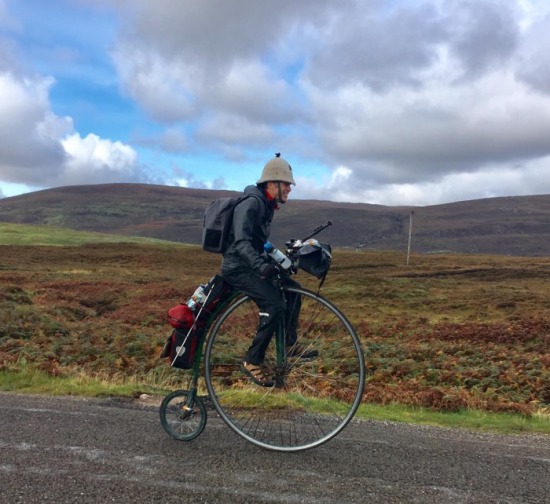
(We discovered that this worthy is one Joff Summerfield. He is an ex-Formula 1 engine designer. He sold up and built his own penny farthings to create a world-circling piece of both ancient and modern engineering. We were lucky enough to see him on his circumnavigation of the new NC500 route around Scotland… Wonderful!) Read about Joff here.
By 13:00 I was getting grumpily tired. Over the Kylesku Bridge the rain really hammered down again, so none of the lovely mountains were visible. Finally the turn by Loch Assynt and on into Lochinver. Straight to the Pie Shop for a late lunch. Revived we did a frantic, slightly mind-numbing shop in the local Spar, then headed off to Culkein.
Brisbane Chalet was clean, tidy and as delightful as we remembered… Settled in and drank wine with some pasta and pesto… Outside the light was fantastic, Quinag being the focal point from the hut. It glowers and shape-changes with the light and weather, is never dull and always lovely. Bed early, with the sunset, and a quick drift into penny farthing filled dreams….
Day 5: Culkein
A long, silent sleep. The autumn days are not the never-ending ones of high latitude summer any more. Sunrise is 07:20, and sundown just after 19:00. I was up with the dawn and made tea. Passepartout came out to join me. Outside it was bright and overcast, and the tide was reaching its height. The short stretch of sandy beach held some 40 oystercatchers, a few common gulls, and some ringed plovers. As we watched they all leaped into the air to circle, startled over the bay. This was a ‘dread’ and usually happens when a bird of prey is overhead. In from the sea came a huge juvenile white-tailed sea eagle! Massive ‘barn-door’ wings and huge bill making the head look ‘heavy’. It cruised by, wings beating slowly, eventually disappearing over the skyline towards Loch Cul Fraioch. The birds settled again. A grey seal poked its nose out of the water on the far side of the bay, and the roost was bolstered by some turnstones, rock pipits, and a couple of curlews. One curlew has a left foot missing, so we’ve called it Stumpy. ‘He’ looks fine, with good plumage, so it seems to be coping very well. A lone redshank joined the beach party as did a single grey heron.
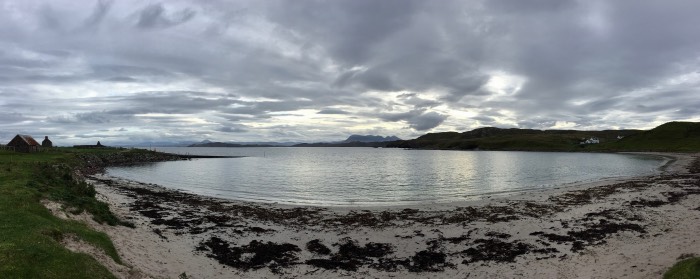
All around starlings flew in small, feeding flocks, a pied wagtail hawked for insects in the grass and a stonechat busied itself around the hut. By the jetty a female red-breasted merganser ‘steamered’ through the water, chasing surface-feeding fish. This technique is fun to watch: head down, just under the surface; then a sudden surge of frantically paddling legs (like a paddle-steamer’s rotary paddles); once amongst the fish, zigzagging, dipping and full submersion, this way and that, before stopping to ruffle feathers back into place. A lone raven flapped over the whole busy scene.
At midday, in brighter weather, we wandered along the coast to the sea arch at Rubh’an Dùnain. Out on the ebbing sea shags fished constantly. We found lots of different fungi to look at and photograph, along with a large fox moth caterpillar (last found in the Blaven car park in 2017). I next spotted a large (dog?) otter in the kelp-strewn shallows. We watched him rise and dive a few times before he slipped away. Rock pipits scurried along the low tide line and meadow pipits flocked over the close-cropped sward. Down below a red-throated diver (juvenile turning to winter plumage) successfully fished for what looked like sand eels. We drifted back as the tide turned, walking to the piercing calls of squabbling, chattering oystercatchers. At the old croft ruins and sheep pens a small flock of twites fluttered around the gateway, dancing up and away upon our approach, twittering like baby Geiger counters as they left. Overhead two patrolling ravens croaked past, one after the other, glossy black, feathered throats moving with their calls, heads turning as they look for dead things to eat. Had they called ‘Nevermore!’ we may have stopped to stare, but, instead toddled to Brisbane for a cup-of-tea.
A gentle drift into evening with the tide filling the bay. Stumpy has been feeding, limping amongst the bladderwrack enveloped rocks, long bill inserted through the weed like a surgeon’s lancet, a jiggle and swallow, then on again – he flew off as the tide rose. As the sun dips, Quinag’s slopes turn apricot, as pied wagtails scurry after flies, or test apple cake crumbs sprinkled on the gate posts… the male seems to like it. Pasta, tomato sauce and wine. An early night beckons. Ben Stack tomorrow? It would be the perfect birthday activity…
Day 6: Old Men of Stoer
The temperature had dropped a few degrees. I woke up as a 63 year old, and there was a definite chill in the air. Up to make tea around 07:00 and Quinag and Ben Stack were all but invisible behind grey rain clouds. The tide had rolled up to the sandy beach in steel grey rollers, thundering into submission on the golden grains, cheered by common gulls in plaintive yells. The oystercatchers hunkered facing the wind, as around them meadow pipits tumbled and danced on unfamiliar ground, snapping up wrack riding flies. A single dunlin bimbled about, unselfconsciously disrobing from summer finery to winter-sensible plumage. Undeterred by the choppy water, our lone grey seal poked its nose out, where it bobbed like a slate-dark gourd. It occasionally slid effortlessly beneath the surface, only to reappear to resume its casual gaze at the world of sun and clouds.
We lingered in bed until the cold seeped in and clothes held the promise of greater warmth. Passepartout made more tea and then discovered my porridge oats were actually coarse milled oatmeal! Undeterred, she boiled and beat the confusing matrix of milled grains into a surprisingly palatable meal, flattered with honey and eaten cautiously, lest it set in one’s mouth. The weather looked out of sorts. Ben Stack was still hiding. Thus I made an executive decision and pronounced a circuit of Stoer was the best present a chap could wish for, reinforced by booking a table at Peet’s Restaurant in Lochinver for 18:30. Not enough time to fit a late visit to Ben Stack too.
By 11:00 the weather had decided to be sunny, and so were we. We left in walking kit to try a slight route variation on familiar terrain. Up through Culkein we marched, the view opening out into panoramas of ocean, rocky shores and the shadowy Torridonian nunataks looking altogether like pillars for the sky. Soon, we turned west along a track which skirts Loch Cùl Fraioch accompanied by a single meadow pipit that kept popping up, flitting a few metres, then dropping down in the tussocks ahead. The Loch was still, a natural mirror reflecting the blue sky. Every puddle, pool, lochan and loch was blue. The cnoc and lochan scenery formed a patchwork of green and blue, good enough to make into a print for rich fabrics.
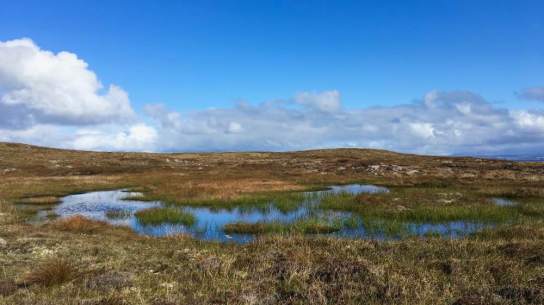
Next to a water-filled boat, on the path, Passepartout found another nomadic fox moth caterpillar. We’ve subsequently read up on this fur-coated creature. The moths are mid-sized, relatively ordinary yellow-beige animals, but their caterpillars wear resplendent deep brown and orange-stripped mink coats. They grow large, up to 3.5”, munching their way through the landscape. Come autumn they do not pupate, but find a snug place to hibernate, warm in their furs. In April they emerge and sunbathe, no longer feeding. It is thought sunlight helps it adjust to the rigours of pupation, for once some days in the sun are completed, it does just that, and the cycle begins again.
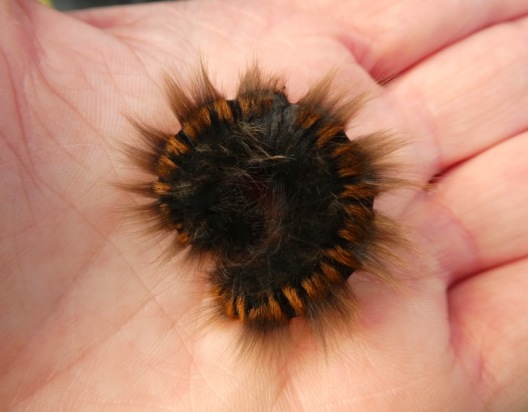
After the loch I led us SW through boggy ground towards a mast-topped hillock. The going was tough, the thick mat of boggy plants forming a bouncy surface on the wetter bits. Some of the peat hags were topped by soft mossy shag-pile carpets, and looked for all the world like pillows. Squelching onwards we finally reached the top and dry ground. There before us were those sky-pillars made from the oldest rocks in Britain: Quinag, Canisp, Suilven, Cul Beag, Stac Pollaidh, and Ben Mor Coigach. Further north Foinaven, Arkle and Ben Stack were prominent, and to the south we could make out the Cuillins of Skye.
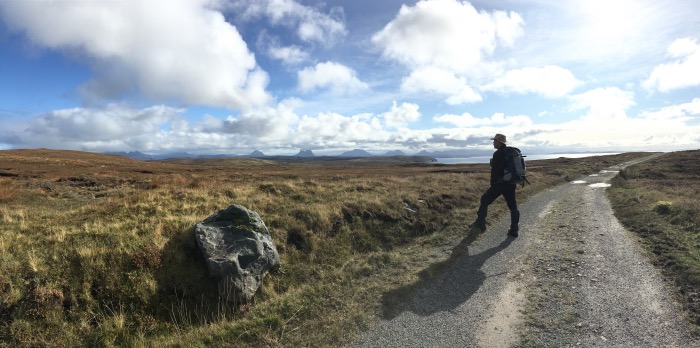
Down we plodded, ever gazing at the scenery changing in the light as we walked. At the lighthouse the snack hut was closed. Out at sea gannets circled and dove into the water fishing, deadly fish-seeking missiles flashing white in the sunshine. From here we set off north over the hilly ground beyond the Stoer Lighthouse. There is a deep gully down which we had to descend on uneven, rocky steps, and here we saw a late wheatear, big and colourful, flashing its ‘white arse’ from the far steps and rocky perches. (It may well have been on the way to Africa from Greenland!)
Accompanied by the booming Atlantic rollers and a croaking, hopeful raven, we finally dropped down towards the Point of Stoer, where this 63 year old man could admire that other venerable fellow, the equally Old Man of Stoer. As these two Old Men of Stoer looked across the years at each other, Passepartout tugged my sleeve as she drifted into a condition known in my native Somerset as ‘arse collapse’, a point of debilitating fear…it was very steep. We turned for home, over the ridge to the cliffs at Geodha an Leth-roinn, skirting them back on tired legs. We had brought no food, so I was starting to sag a bit. Water was all we could sip, but we could see Culkein and it lent wings to our wet and weary boots. A skein of greylag geese honked over, the waves were blasting spume and spray into the air above the arch, and we quickly covered the ground to the raddled sheep pens, where a swirl of tea leaves stirred above us, twites chittering away into the blue beyond.
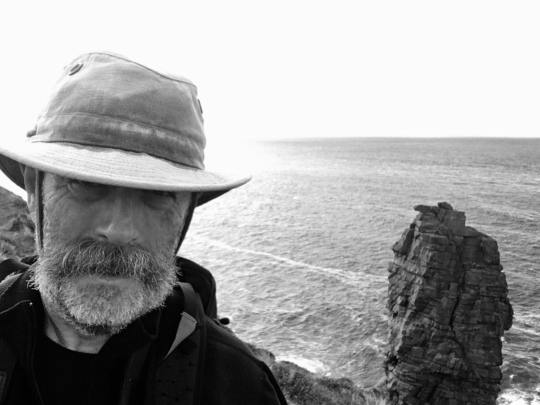
Tea and biscuits. Then I had a quick dribblesome shower and dressed to leave for Lochinver. Peet’s had put a ‘Happy Birthday’ banner up by our table: special me, an Older Man of Stoer. Bread and olives, scallops, then a fish platter – all fresh and sweet, all cooked in light batter… very Scottish.
Home under starry, darkling sky, headlights showing our winding way, a single tawny owl flapping into some dense stunted woods, and a fading dusk light moving towards America. Home for a glass of red, and the sudden chill of winter’s coming filled the hut. Bed to snuggle for warmth, shrieking like children at chilled sheets and loving the wild sounds of night rollers on the beach. A perfect birthday…
Day 7: Knot much, and a Pie.
We both slept like logs. So warm under duvets, but up making tea I soon chilled to the bone again. Outside, big rollers were pushing the tide up the beach, the full wash of breaking water reaching the highest strand line. In the surf the big grey seal, surely a male, poked its nose skywards. A trimmer, neater female swam near the hut, fishing and making light of the surfer-grade waves. Passepartout photographed a rainbow behind the hut. Back to bed to read and drink tea.
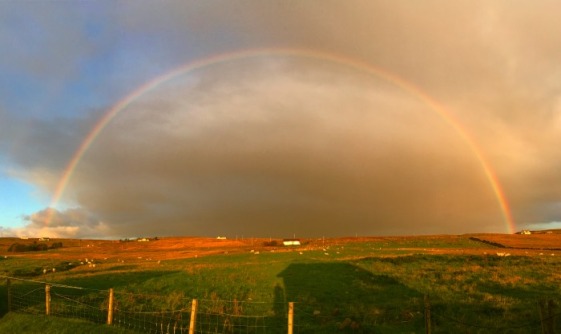
Once up we looked out on the day. The rollers smashed against rocks all around the bay, foam painting the whole coastline with jagged borders, as if splattered by a mad artist overwhelmed with a white-on-dark impressionist fervour. Heavy showers tore across the seascape, whipped across mountains, roared up valleys and paradiddled against the glass through which we watched. We sat and watched and found we were both tired. Passepartout was still gripped with an irritating, post viral cough and I was weary from driving, yesterday’s plod and celebrations.
The weather is set fair after today, so I pronounced a rest which was well received by my coughing Passepartout, so we drank tea, ate orange Club biscuits and Tunnock’s wafers. Yet, even this is not wasteful here. Outside the driven tide was trying to ebb, the moon and storm surge at tumultuous odds, tossing kelp, weed and flotsam high into the air. Yet the moon had to win, and the sand emerged to coax the waders back to feed. Oystercatchers and ringed plovers eyed the surf as they fed, and the dancing meadow pipits returned to find storm-damaged flies. The waves edged ever backwards and Stumpy the curlew appeared to probe and prod amongst the weedy rocks, surprising us by finding, and eating in a gulp, hiding peeler crabs – soft bodied after shedding their exoskeletons. I think Stumpy is a female, as she is large, with a very long beak.
As the morning drew on, a lone juvenile black-headed gull blew in to rest, as shags fished in the waves and a lone robin sang to us from atop the mobile home opposite. Robins are forest birds by inclination, but their adaptability is well shown here as the nearest woodland is miles away. Down on the beach a couple of new waders appeared to feed busily amongst the oystercatchers. Silvery plumaged, with light superciliums, one with a slightly rosy chest. These were a couple of knot, fresh from a journey from the high Arctic, often found in flocks of thousands, but here happy enough to feed together, my first of this species for years. Turnstones appeared to turn stones and weed, as the farmer, with the aid of his collies, hunted a small flock of dopey sheep towards the pens.
As the showers eased we decided to drive to Lochinver for a late lunch. Along the winding road through Clachtoll, through cnoc and lochan strewn ancient, boggy land, thickets of hazel woodland, ice-rasped gneiss outcrops and steep-sided banks. A quick dash to the Spar for teabags and biscuits then into the Lochinver Larder. Passepartout ate stewed steak and porter, with mash and gravy. I settled for a Stilton, broccoli and cauliflower pie with salad. The pie shop is full of pies! Hundreds, in piles and scatterings, all lovely, each a single meal.
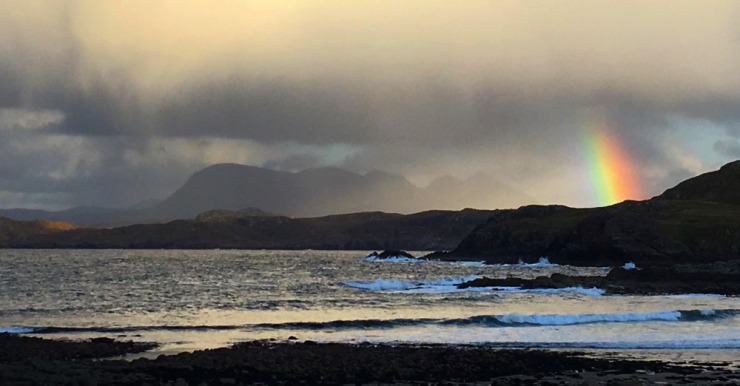
It poured with rain as we left, a rain shower of industrial strength. Back towards Culkein and the sun came out again, blue sky and more rainbows in a day then is normally see in a year. And so we drifted to evening… Passepartout cooking a chilli sauce for tomorrow, whilst watching Quinag change by the minute – bright and sunlit, then rain hazed, then the source of a vertical rainbow… ever changing. The hut is a wood block of nothingness, but it is the best place in the world to be, to see, to watch and to rest. And what of tomorrow? Ben Stack calls us and the weather looks kinder. So, we’ll rest and watch the colours change through the evening, and then go to bed with the sun…
Day 8: Ullapool for An Teallach
Another mixed weather morning. The tide rolls in a little later each day, and at 08:00 the rollers were crashing higher than ever. Oystercatchers were probing the grass outside the windows as the beach was too turbulent to use. We’re a bit unsure what to do: the mountains are invisible under black clouds and our urge to roam by foot is being thwarted. October is always a difficult month to yomp. I am tired, but in a nice way. Just relaxing into the natural sounds and enjoying the ever changing view. Rain lashed the windows and I suggested a drive down to Ullapool.
Out on the sea white horses bucked and reared over the waves. The sun shone, then disappeared behind clouds, the rollers roared and a form of lazy acceptance came over me. I want to walk and climb and see; not stagger through rain to see nothing. Suilven will have to wait and our targets need to be dynamically chosen. It’s all we can do. By the time we are ready to leave, the two knot, oystercatchers and ringed plovers are huddled, waiting for the tide to recede. As I watch the sun is out and it’s raining. Another rainbow. Rain fizzes over the sea and it changes from grey, to green, to blue, flecks white, pulses and seethes. Gone behind rain, lit by sun…everything is a pictorial rendition of anachronistic non sequiturs. Oxymoronic vistas. That mad painter trying to fit every type of weather into one illustration. A beautiful insanity. There is a minute where we are surrounded by meadow pipits. They are raiding the hut, searching gutters and windows, nooks and crannies, splits and knot holes, for cowering spiders or sleepy flies. Then gone, dancing in the wind, shouting ‘peep-peep-peep!’ at each other in avine boasts of arachnid feasting. I’ve waxed too lyrical…off to Ullapool before the mad painter returns….
The rain came in spasms. Lochinver was damp as we headed the wiggly woggly way, over the River Kirkaig, with views of the base of Suilven through the low rain clouds. At the T-junction by Loch Bad á Ghaill we turned left and skirted Stac Pollaidh then down, through the rain to Ullapool. At the Seaforth Hotel we settled, but was rattled by the news that there was no An Teallach ale! The brewery had closed (owners retiring) and their outlet shop on the high road was closing…today!! We drank a Belhaven IPA with our Haddock, chips and mushy peas: that’s three times we’ve eaten this in a week! Happily full, we toddled over to the Ullapool Book Shop to browse and buy. Here Passepartout announced her Mummy had supplied funds for a book-prezzy – heaven! The Forager’s Calendar, by the lovely John Wright, and the updated Corbett book…perfect. Thank you bothly!
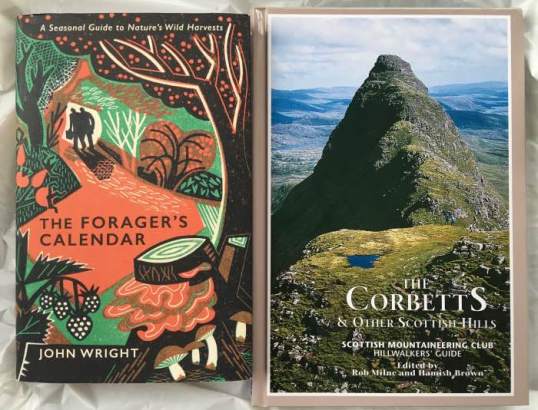
Up to the closing An Teallach outlet. 6 beers, several bags, beer mats and glasses for £12 – a bargain, but a bit sad. The young chap in there was the brewer, had kept the recipes, and was off to work in Paris. Good man says I.
We took the easier route back. By now the weather was better, but none of the mountains were clear to see. The Knocken Crag looked formidable, the huge Moine Thrust sitting solidly over the ancient fault line. Inchnadamph was good to see, with the crumbling Ardvreck Castle – some quick pictures and on to Lochinver. Parked up and there walking to the car park was Steve McClaren and his wife…I’d wondered who owned the Aston Martin… couldn’t help thinking ‘Wally With The Brolly’… he seemed nice enough. Spar shop for a few bits, then off to Culkein.
The bay was roaring with rollers again. The headland arch was a maelstrom of foam and the tide was surging in again. We wandered to the slipway to take some photographs then retreated for the evening. Curlews called and the waves filled the bay as darkness fell. I penned a poem in remembrance of the An Teallach brewery:
Ode to An Teallach Ale
All the way to Ullapool,
To drink An Teallach ale,
Just the job with fish and chips,
A meal that cannot fail.
But ‘No!’, the brewery has closed down,
It’s gone, that mighty beer,
It’s shop was shutting up today,
So quickly there we steered.
This ode is to my favourite brew,
I’ll miss An Teallach beer,
The mountain’s there, the booze has gone,
Such things doth beer fans fear.
Day 9: Very Oldshoremore
A gentle morning watching the weather. The wind was still strong, so over tea we planned our day. We decided on an afternoon trip to Oldshoremore, left at 13:00 and drove through sunny landscapes north. Kylesku, Scourie, then off the main road to Kinlochbervie and down a narrow road to Oldshoremore beach.
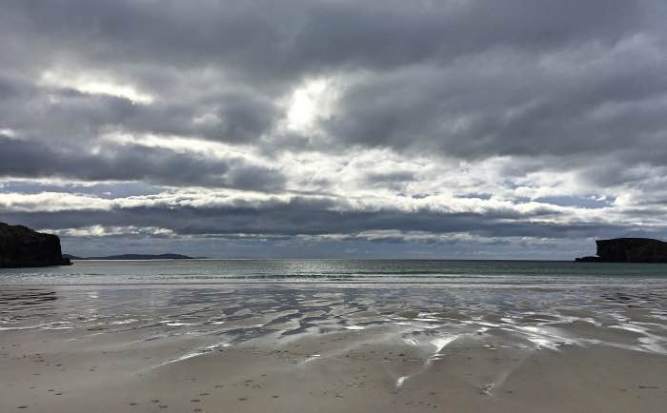
Up the footpath and over the top and there it was. Golden sand, green sea, and lots of rocks. Last time here (2014 I think) we found a minke whale carcass. Today the beach was swept clean. A gentle stroll to a flat, rocky outcrop and the day changed. I was looking at a huge area of beautifully presented Torridonian sandstone. Smooth pebbles set in a sandy matrix: a conglomerate rock that is between 800 million and one billion years old! It is made of water eroded mountain rock from a long-gone ancient continent. This had washed into a huge valley, been crushed into new sedimentary sandstone and lifted up to form another set of mountains. These are now nubs of what they were. Suilven, Canisp, Quinag, An Teallach and many others are made wholly or partly from Torridonian sandstone. This sandstone formed atop weather worn Lewesian gneiss bedrock. Thus beneath you have 3 – 3.5 billion year old rock, with a topping of 800 million year old sandstone!
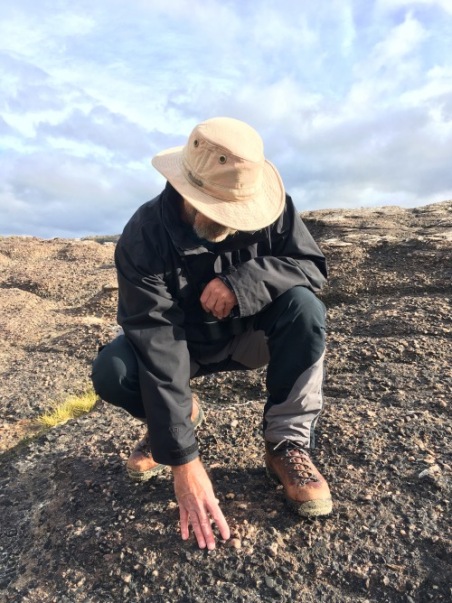
The cliffs were just as fantastic. The weathered faces showed many of the Moine Thrust Belt features. Igneous rock intruded with metamorphic rock and fissures full of quartzite. I was, and am, blown away. I found a big lump of sandstone to take home – the only other bits I have are small from the tops of An Teallach, Liathach and Slioch.
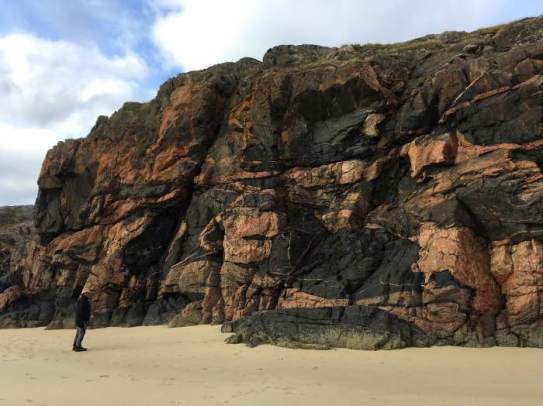
We left and had a look at Ben Stack. The wind was tremendous, so whether we try this tomorrow is in the balance. Saw a little weasel dash across the road as we dropped to Loch Assynt. Back to The Hut to end a quieter day. At 21:40 the wind is moving the whole structure and whistling through cracks. The windows bulge and it is like being at sea in a 18th Century Man o’War! We battened down the hatches…
Day 10: 52+8+3 and the Lochinver Larder
Eyes open and the sky was blue, but the clouds were scudding. Rolled over and wished my Passepartout a ‘Happy Birthday’. I delivered tea and biscuits in bed. She was so happy. Her Mummy’s card made her happy. The day made her happy. Passepartout is a happy 52!
What to do? Ben Stack was out… it felt wrong. Outside the bay was still stormy, but there was a less frantic edge to the waves. We watched a shag in the shallows fighting with an enormous flatfish. Several times it tried to swallow the poor thing, but each time it spread it’s edged fins and the bird was defeated. A hungry great black-backed gullwatched from nearby. To our delight the shag eventually let the fish loose once too often and it must have made an escape.
We made a decision. Passepartout wanted a birthday meal at the Lochinver Larder. In the meantime I wanted to run.
I put on my hydration belt with a bottle of water, and wrapped my phone in a clean bread bag, placing it in the second water bottle holster. I ran for a mile or so uphill and turned down towards the Stoer Lighthouse. This is an undulating route which is hard on the legs, but I ran easily, taking a few pictures in the way. Just after the Clashmore junction I saw about 5 redwings take to the air from a clump of dwarf firs. They called shreee! and dashed off. These are winter visitors, so my first of the season. However, a few pairs do breed up here and I saw a male singing in July 2007 by Ben Hope. On around the headland and eventually to the Lighthouse, up the steep, short zigzag to the gate. A nice chap took my photo and I set off back feeling fine. Took the iPhone out for a photo and tucked it back.
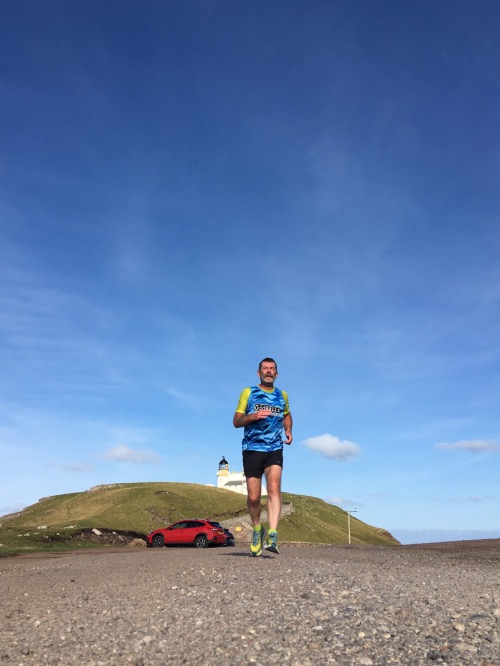
After 6 miles I was climbing for to the highest point and felt relieved to reach the top, decided on a last photo and discovered my phone was gone! Bugger! What to do? I had to retrace my steps, so started jogging back… past the Clashmore turning, past the Balchladich junction… worried now. Would Passepartout be frantic? Up ahead two cars were passing at a farm entrance… I gestured the driver of a black 4×4. He told me a bag was in the road some 200 yards further on! He’d driven around it as he thought it was odd. A quick dash and there it was – bread bag wrapped around phone and mini-stand… gently opened it and it was intact, undamaged and worked! At least 5 vehicles had been this way and all must have steered around it…it was right in the wheel track bit! Phoned Passepartout and explained…she said it was still well inside my predicted time, so was not worried. A wren skittered along the wall next to me and a dunnock flipped into the shrubs. I figured out I had tucked my vest into the holster with the phone when I took that last photo. I recall pulling my vest here as it felt a bit ‘caught’ and that was the moment it popped the package containing my phone out, silently hitting the road in its soft wrapping.
Back up the long climb. I set my Strava app to record the extra bit of running. Knackered by the time I got to the point I’d turned back, 1.5 miles from where I found the phone! Thus I’d ran 3 extra, very hilly miles. By the time I dropped down into Culkein I had covered 11 miles and I was tired. No time to tarry, a quick shower, on with togs and off we set for Lochinver.
We ate at the Lochinver Larder. Outside I saw the same black 4×4 and chatted to the chap about my phone. He, and his two female passengers knew me as the ‘phone man’ and were glad all worked out well. Langoustines starter; Passepartout then ate haddock, piri piri and lime fish cakes, I had cauliflower, broccoli & Stilton pie again, with mash, peas and onion gravy; a creamy lemon tart for Passepartout to finish. We drank a jug of water. Passepartout was very happy!
By now I was pooped, but we drove the winding way back, taking in Balchladich and the Stoer Lighthouse. Back to Brisbane. Out over the bay a flock of some 300 kittiwakes had blown in to settle on the calmer sea. I had to lie down for a bit, whilst Ange went to the beach to explore and take photos. I really was knackered.
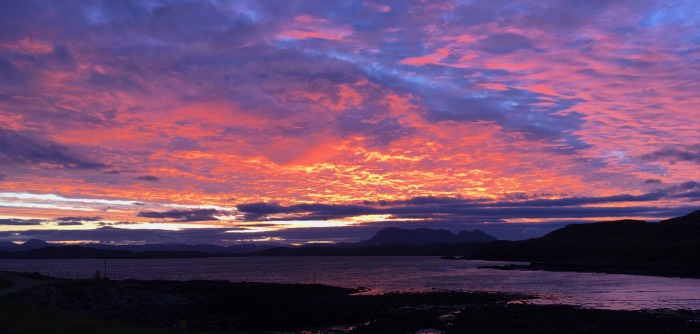
A quiet evening. Tomorrow we leave, but this time there is no rush. We are due at my brother’s around 17:00, so we can pack in the morning and coddiwomple rather than dash. All in all it was a lovely day. Each of our birthdays were blessed with the best weather, and each with good food. I will sleep well tonight…
(…and the formula in today’s title? 52 Ange’s age + 8 planned run + 3 extra miles = 63 my age.)
Day 11: Culkein to Dunphail
Up with a glorious sunrise. The scattered clouds over Quinag glowed golden as Sol climbed up to greet our last Sutherland morning. A few biscuits in bed and then up to start the job of packing, loading and cleaning.
Outside, the oystercatchers piped, Stumpy the curlew limped amongst the rocks by the slipway and ringed plovers tore around the lower beach on clockwork legs. Then I noticed two silver visitors feeding along the advancing tideline. A pair of beautiful bar-tailed godwits had dropped in to refuel on their way south. These super, mid-sized waders are more silvery, compact and neater than their larger black-tailed cousins, and have a tightly barred tail, rather than the latter’s thick black margin, set off against a white rump.
Collapsing the telescope was a final birding act in the Hut, but the two godwits flew up and over my head piping as I finished packing the Mazda. All tidied, we set off towards Ullapool. We dropped the glass recycling at the Clachtoll camp site, then set off south in earnest.
Assynt, Ardvrek, Elphin, Ardmair and into Ullapool where we stopped for a breakfast at a The Tea Store café. We pressed on and I decided to do the big detour past Gruinard Island and Gairloch. We goggled at the mighty An Teallach, gazed at the Fisherfields, and enjoyed the extended tour of the West Coast. Down along Loch Maree and the lofty Slioch.
From here we took the quickest route possible down to Inverness, passing Ben Wyvis on the way. A brief stop to fill the tank, then on past Culloden, to Dunphail for 17:10. I’d covered 200 miles and was tired. A lovely meal (chilli and prawn fish cakes and rice with salads) a few beers and an early night…
Day 12: Dunphail
I slept poorly for some reason. Dreams and a period of wakefulness from 02:00 to 04:00. Driving seems to wear me out lately. Up at 07:30 – tea for Passepartout and a breakfast of muffins. A lovely jay hopped around the lawn, as coal, blue and great tits, chaffinches and collared doves fed at the bird tables.
Later in the morning we walked up the road and did a recce of the new wind farm, marvelling at the huge turbines whooshing around above our heads. On the way back we were luck enough to see a red squirrel.
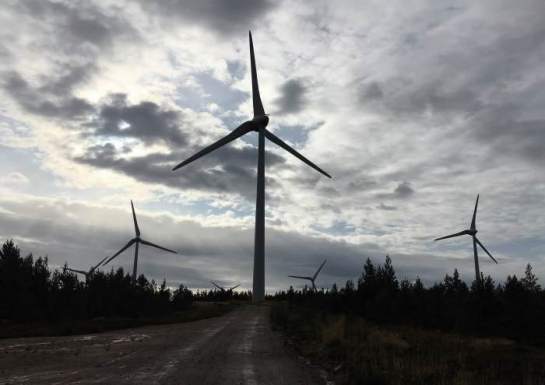
Sunday dinner of cauliflower cheese, peas, carrots and golden roast potatoes, followed by apple crumble and custard. I was stuffed and incredibly tired. We watched a couple of movies, chilled until an early bedtime for me. Tomorrow we start the long journey home…
Equinox to Solstice
It has come to pass in recent years that the autumn equinox and winter solstice each mark a holiday for me. In 2019 the equinox occurred as I was about to set off with my Passepartout on a Bothday journey to the north of Scotland. The winter solstice came by as the Yule festivities began. Between those two events, the world’s tilt pushes the Northern Hemisphere into ever longer nights and shorter days and nature adjusts. In this respect, nature includes me – I’ve never thought of me being anything but a mammal, so the effects of the seasons should, and do effect me personally.
Our northern journey gave me a clear view of the autumn passage. In spring, migratory birds move north to breed, but by August, our summer residents start to drift south in every increasing numbers. Swallows were very noticeable, even as far as John o’Groats, as they flew down from their most northerly breeding grounds. That they were joined over the Pentland Firth by red admiral butterflies was quite an eye opener. Yet, what the layman may not consider is the continuity of migration. Even further north, high in the tundra and coasts of Greenland, Iceland, Arctic islands and Siberia, other migrants moves south to Britain, where the weather is balmy, for them. Indeed, the Vikings settled our northern isles, then declared the Land to the South as rich and worth taking, hence Ben Hope (Beinn Hòb in Gaelic) – the “mountain of the bay”, become their navigation marker for Suðrland, our Sutherland – literally, “southern land”.
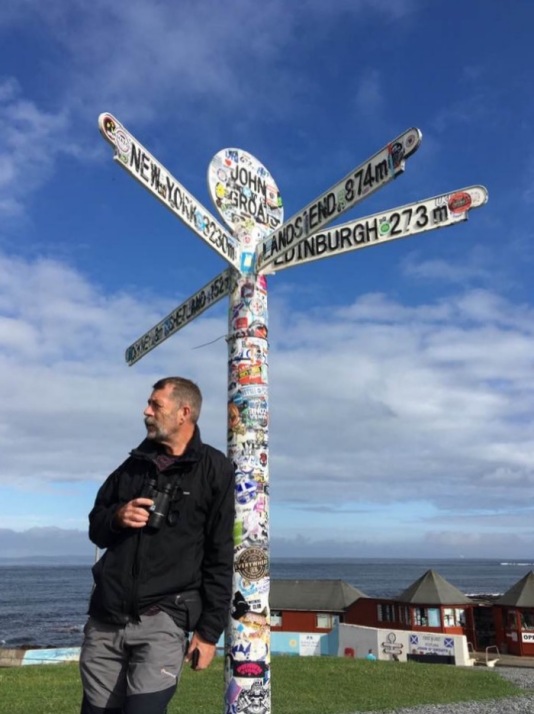
As we settled into our hut at Culkein Bay, we watched summer migrants moving south, including a late wheatear, whilst winter wanderers came through – bar-tailed godwits, knots, dunlin and a handful of redwings. Many of these were still wearing the vestiges of their breeding plumage, but once on the wintering grounds full winter raiment would be donned. Many geese, waders and passerines would stop near my home in West Sussex, but more would remain in Scotland and others continue south. Arctic terns fly to the Southern Hemisphere and have even been recorded in Australia!
Once home the winter creeps up. My commute goes from twilight to dark, the autumn passage grinds to a halt and the wintering dark-bellied brent geese settle into Chichester Harbour whilst their breeding grounds are covered in snow and cloaked in permanent darkness. A few hardy summer visitors have always clung on in the south of England where, if they survive, they have a head start on territorial migratory rivals. This winter I had a blackcap and chiffchaff in my garden – global warming will increase these numbers, no doubt.
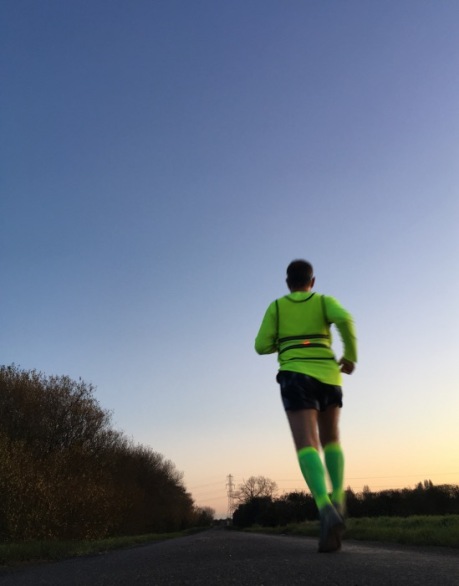
My own journey to the solstice continued on foot. A late start to the year through illness meant my initial target of 1200 miles was improbable. Even though I managed a marathon in April, any aspirations to compete in the Race to the King 53 miler in June disappeared with further tendon injuries… So I was on catch up, revised my target to 1000 and ground out the miles. On December 7th I happily ran a 12 miler leaving me 81 miles to go. I was right on target. The following day my chest was sore and once more I was brought low. A debilitating virus knocked me off my feet, followed, just as Yule gave me time to run the remaining miles, by my first ever bout of shingles.
Denial gave way to acceptance, then to worry as I felt dreadful. So I ended the year on 919 miles with an ongoing life total of 37,737. As I left the solstice behind and 2020 started, I had recovered enough to jog 4 miles. This year I’m aiming for 1100 miles and I’m ahead of 2019 already. On 22nd January a minor virus tries to bring me down, but I think this is winter’s last hurrah. Imbolc beckons and the migration north will gently start. I will soon hear spring’s visitors in the hedgerows as I trot past and will watch the brents murmuring in their ever decreasing groups as they make final plans to fly back to the ice-free tundra.
My final nod to the retreating equinox was to remove all my nest boxes for a clean and paint, ably helped by my Passepartout. As we worked The Chaps, my delightful clan of marauding long-tailed tits, drifted through to grab a swift meal from my hanging fat log. They call “shri-shri-shri” to each other, a little cry of reassurance – “I’m here – I’m here – So am I!” is a rough translation.
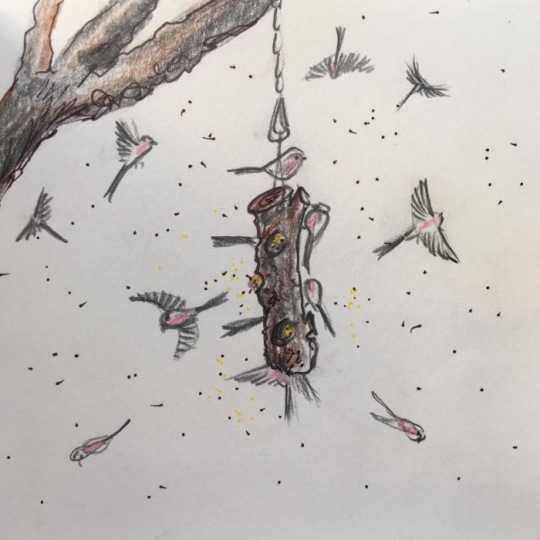
Notwithstanding The Chaps, cleaning continued, with old horsehair-and-grass woven nests and slumbering parasites removed to give the birds a clean start. Refining and rearranging came next and, with a final flourish of a hammer, everything was done. However, one never-used box had been moved from a soon-to-be-replaced fence post. Every evening since a little blue tit has arrived at twilight, circling the place where his roosting box once was. That it is now on a nearby tree has not registered, but there are plenty of other places, so I admire its persistence, if not it’s bird-brain, and, feeling a little guilty, watch each eve as, after a few minutes the little waif finds lodgings elsewhere.
All website content ©Paul Comerford, author, unless otherwise stated. All rights reserved.
